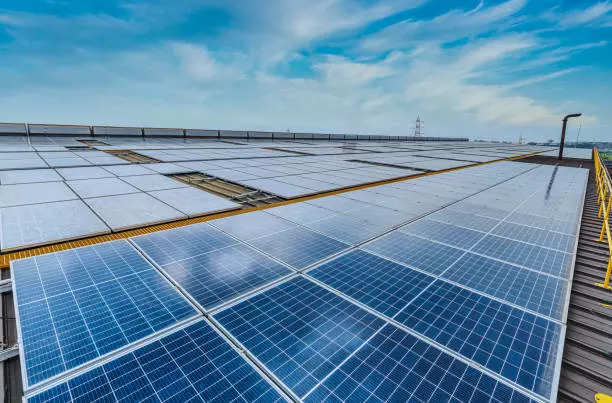Does living near Solar Farms make you susceptible to Cancer? What does Research Say About it?
Solar Farms are the in thing and are growing in numbers around the world. But is it safe to live near solar farms? What are the health implications of living near solar farms? How genuinely safe is it to live near solar farms? Read on to find out the pros and cons of living near a solar farm.

Updated Jun 13, 2023 | 02:24 PM IST

Understand the risks of living near Solar Farms
Photo : iStock
As the effects of global warming and climate change are being increasingly felt around the world, more and more countries are switching to ‘eco-friendly’ ways of doing things, like power generation. Power generation is believed to be one of the major polluters across the world, be it hydro power or thermal power.
Therefore, more and more countries are switching to solar power to meet the ever-increasing power needs. The belief behind switching to solar power is that it is non-polluting and hence eco-friendly. Enormous solar farms are being set up across the world in a demonstration of taking the fight against the impending climate catastrophe.
In fact, in the last decade, solar energy has grown at an annual rate of 42% due to cheaper installation costs and a demand for renewable energy, according to the Solar Energy Industries Association.
However, as solar energy becomes more commonplace in our lives, some people are questioning whether the technology used to build or operate solar panels and solar farms carries an increased risk for cancer.
How is solar energy harnessed by solar panels and solar farms?
The most commonly used technology to harness solar energy is called photovoltaic (PV) technology which is used in the solar panels that you see on the roofs of homes or businesses, or as part of larger solar farms. As the sun emits solar radiation, PV technology uses cells to absorb that radiation and turn it into electricity. That electricity can then be stored in batteries or fed back to the power grid.
Another type of solar technology called concentrating solar-thermal power (CSP) uses mirrors to reflect solar radiation and convert it to electricity. CSP is mainly used in large power plants.
Can solar panels or living near a solar farm cause cancer?
According to Noah Kittner, PhD, Assistant Professor in the department of environmental sciences and engineering at the Gillings School of Global Public Health at the University of North Carolina, “There is no evidence that solar panels are causing cancer”, adding that these materials are self-contained. “They’re used in the panel itself, so the risk is minimal”. He further added that most people do not have direct contact with solar panels even if they are mounted on the roof of their house. In fact, he goes on to add that solar panels and solar farms may actually be a beneficial strategy to reduce the risk of lung cancer overall. In many cases, they’re offsetting other electricity-generating sources that can contribute to air pollution, which can cause [lung] cancer.
Can the materials used to make solar panels increase cancer risk?
Most solar panels are largely made of glass and an aluminum frame, along with other commonly used plastic and wires. Furthermore, the cells on solar panels that are used to capture sunlight are made of silicon, which is a naturally occurring element.
However, disposing of old solar panels or those damaged during storms in a safe and environmentally friendly way is a critical issue for communities, researchers, manufacturers, and policymakers alike. Researchers at the National Renewable Energy Laboratory outlined the most promising approaches to recycling solar panels in a 2020 study in Nature Energy.
Does radiation from solar panels increase cancer risk?
Electric and magnetic fields together are called electromagnetic fields, or electromagnetic radiation. If these electromagnetic fields are on a spectrum, with low-frequency radiation on the low end, which includes things like power lines, and high-frequency radiation on the high end, which includes things like x-rays. Low-frequency radiation is less harmful than high-frequency radiation, which can damage DNA and cells.
The World Health Organisation (WHO) says that electricity from solar panels and transmission to the power grid emits extremely weak electromagnetic fields. Exposure to low-level electromagnetic fields has been studied extensively, and no evidence has been found that it is harmful to human health, further claiming that most scientists and doctors agree that if any health effects exist from low-level electromagnetic fields, they are likely to be very small compared to other health risks that people face in daily life.
However, not everyone agrees with this conclusion. Agencies, like the European Commission Scientific Committee on Emerging and Newly Identifiable Health Risks, have taken a more cautious stance, saying that it’s possible, but far from conclusive, that extremely low-frequency magnetic fields could be carcinogenic, or have the potential to cause cancer, according to a 2015 report In the same report, the committee notes that studies of magnetic fields generated by roof-mounted solar panels are scarce and that no clear cut conclusions can be drawn from these findings.
Listed below are the pros and cons of living near a solar farm:
There are both benefits and drawbacks to living near a solar farm, which are considered very ugly to the eye. Solar power plants produce electromagnetic radiation that can affect the health of nearby residents. These rays are not coming from the solar panels themselves, but from industrial equipment used for the farms. While their effects are minimal, they can cause vision problems and headaches.
Secondly, apart from being a clean source of energy, unlike power lines, electricity generated from solar farms isn’t lost in the transfer of electricity. Some solar companies provide connections to surrounding homes for free. While some people may feel displaced, others may find living next to a solar farm peaceful.
One concern that residents may have when living next to a solar farm is the potential health risk. Too much electricity may damage your electronics, health, and home. However, solar farms use solar panels to store excess electricity. And they also reduce carbon emissions. So, while living next to a solar farm might have some health risks, it’s worth it for the environment. The pros outweigh the drawbacks, so it’s best to make an informed decision before moving in.
Although solar farms are relatively harmless in terms of health, one should be aware of their downsides. If you’re hypersensitive to electromagnetic waves, you’ll need to consider this aspect when buying a property.
On the other hand, the benefits of living near a solar farm are numerous. The cost of energy is lower, the energy generated by a solar farm doesn’t pollute the air, and there’s virtually no noise. On top of that, a solar farm is completely silent when it’s fully set up. The noise from the turbines, fans, and workers in the field are virtually non-existent.
At the same time while solar energy is renewable and is constantly available, living next to a solar farm is not the most ideal option. The sun might not always be visible, making it difficult to generate energy constantly. Therefore, the problem with solar energy is that it isn’t available at all times. Nevertheless, there are other alternatives, and you should be aware of them.
The main benefit of living next to a solar farm is the lower electricity bill. Since solar power is one of the cheapest energy sources available. In fact, it costs only $0.10 per kilowatt hour, which is roughly one-third the price of fossil fuels. It’s also a lot safer than other forms of electricity.
Health risks
Does living near solar farms have any adverse health effects. While solar panels do not emit radiation, the equipment used in these farms does. This radiation may be harmful to people and wildlife. Fortunately, the risks associated with living near a solar farm are not significant enough to cause you to move away.
When a solar farm is in the path of a major storm, it is likely to sustain massive damage. Broken solar panels and other debris would be scattered throughout a wide area. The resulting smoke from solar panels could contain toxic metals and be inhaled by the nearby community. These toxic materials could harm the digestive, reproductive, and nervous systems. Even a few solar panels may have a low-toxicity level, but it still remains a health risk.
Among the health risks associated with living near a solar farm are anemia and behavioral issues. Children are especially susceptible to exposure to solar panels, as they are in their growth stage. There are also concerns about the disposal of lithium-ion batteries.
However, these issues are often misunderstood. The truth is that the risk is minimal and can even be minimized with proper precautions. It is best to stay out of the solar farm during the day when its panels are not operating.
Although living near a solar farm may not seem like a threat, it is important to know about the safety of this environmentally friendly practice. In addition to being a green alternative to traditional electricity, solar farms can even be beneficial for local plants. While living near a solar farm is not a dangerous experience, many people still worry about it. There are, however, ways to minimize the risk of exposure to radiation.
Although there are no direct risks associated with solar farms, they are likely to pose a few hidden ones. The solar panels themselves are made from glass and commonly used plastic, as well as wires and aluminum frames. The silicon cells are what absorb the sunlight and convert it into electricity. Despite their simple composition, solar panels can contain trace amounts of hazardous materials. However, since the materials are contained within the solar panel itself, most people will not have direct contact with them.
Although most solar farms are safe to operate, they can release harmful pollutants into the environment. Lithium-ion batteries are highly toxic, and improper disposal of these batteries may have negative effects on nearby residents. In addition, solar farms can also pose a risk to birds, with reports of dead birds near solar farms.
End of Article
Videos





02:08
What Are Key Differentiating Points In Poonawalla Fin Corp ? | Explains MD Abhay Bhutada

03:23
Breaking News | BJP MP Accuses Leaders Of 'Adjustment' With Congress In Karnataka, Sparks Infighting

03:38
Manipur Violence Erupts Again As Kukis, Meiteis Refuse Peace Talks| 9 Killed In Flare-Up

03:03
How MD of Poonawalla Fincorp Abhay Bhutada Started His Career ? | Business News

03:56
TMC Workers Clash In West Bengal Ahead Of Upcoming Panchayat Polls | Election News













